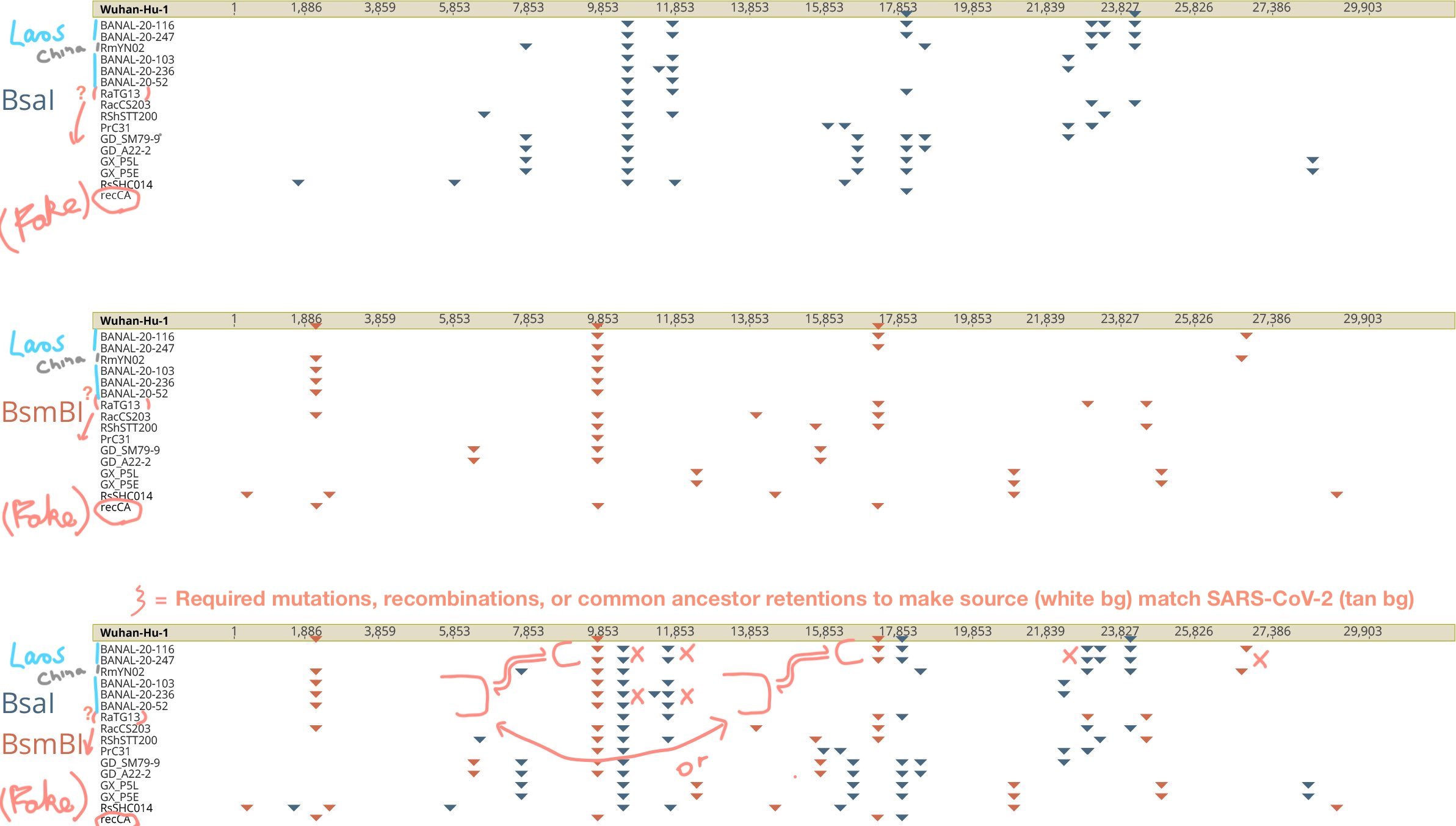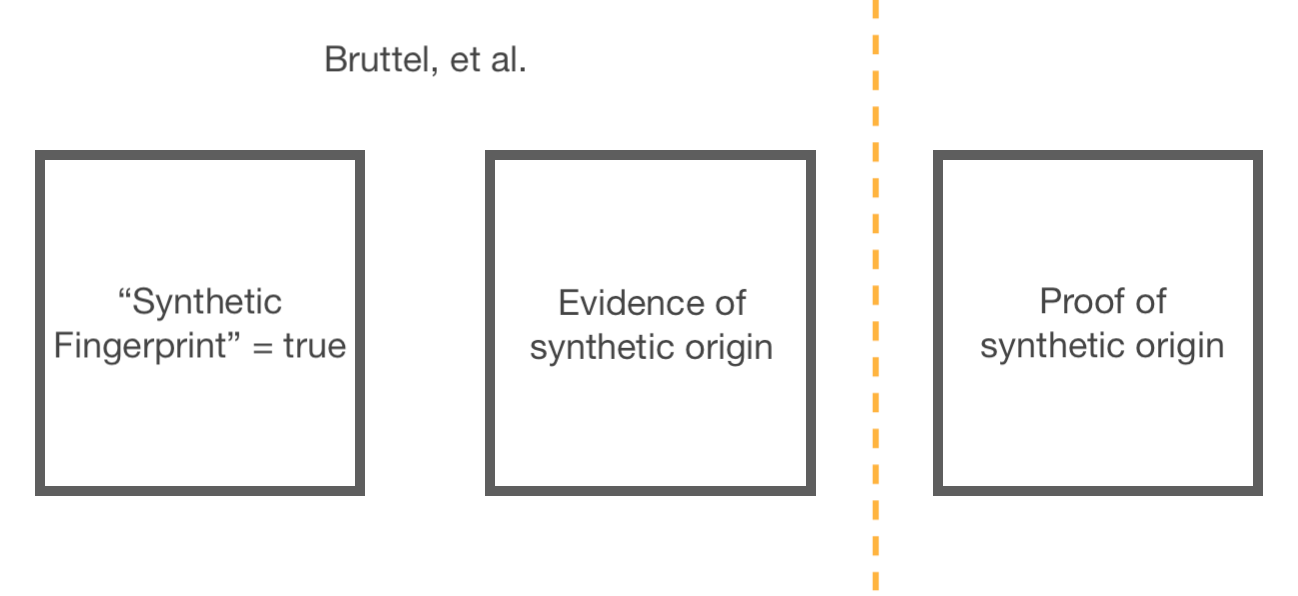Reevaluating the likelihood of a random synthetic fingerprint (updates to "Refining"...)
Steelmanning the case for a natural origin of the synthetic fingerprint.
Monday’s post has been revamped a bit, to present a more nuanced discussion of the argument that a wild virus could have achieved SARS-CoV-2’s restriction site fingerprint randomly. Specifically, I had the exciting realization yesterday morning that a BANAL progenitor virus would have multiple (but not unlimited) ways to randomly achieve a bona fide “synthetic fingerprint” of this type by chance. This makes the topic even more fun to think about.
In my rewrite of the section in question, I added a clarification on the distinction between the synthetic fingerprint as, by itself, “evidence” vs. “proof” of a synthetic origin. It includes this incredible, budget-busting graphic:
The updated portion is here, as well as cross-posted below. (The original comments are preserved in the footnotes.)
Continual Release Gaining Steam
Readers may also be aware that Monday’s post arrived at the same time as Mathew Crawford and JJ Couey’s thrilling discussion of the latter’s argument that SARS-CoV-2 is being continually released from a DNA master copy, exactly (except not actually exactly) as I have been saying.
While I disagree with Couey’s conclusions that RNA is too unstable to permit sustained transmission of a virus’s genes at high fidelity (in fact examples of virtually infinite genome fidelity exist in RNA viruses), I am fully in support of rejecting the assumption that SARS-CoV-2 was ever really a self-sustaining fire burning through a fuel, fulfilling a pre-scripted narrative about Pandemics™ that the media has conditioned us to take for granted for several decades absent any modern precedent. (There is a reason I have always placed that “™” there, after all!)
My case for why perpetual release was likely occurring even outside of “update releases” (the Variants of Concern), at least up to the advent of the Omicron Era, is more nuanced — it is more like a “call” that I make based on the totality of evidence; I do not think we were looking at a self-sustained virus in 2020 and 2021. (This is also why my answer to the question of whether the virus SARS-CoV-2 is driving the symptoms globally attributed to Covid-19 is not deterministic.)
Along with rejecting the (probably op-seeded) meme that the experimental mRNA transfections (“Covid vaccines”) are “causing variants,” I hope increasing recognition of the case for intentional, perpetual release can be rolled into challenging the assumption that bioweapons are such a big threat as advertised (at least, when not injected). As Couey puts it, once we stop buying the line that this level of illness is what we should expect from a novel virus, actors responsible for current conditions can no longer hide from awareness of their (I think likely) actions. Dispel the illusion that vanden Bossche “predicted Omicron,” and it becomes obvious that a lab somewhere made Omicron.
Crawford, Couey and I will hopefully be able to have a productive discussion on this overall concept-bracket (a zoom call yesterday went well in verifying significant same-page-ness).
In the meantime, I would point readers to one of the fruits of my previous work on this issue, my re-assessment and dismissal of the case that the Spanish flu was much, if any more pathogenic than a normal flu:
Excerpt / Cross-post of revisions to Monday’s post:
The second [criticism of Bruttel, et al.] is that the actual, end BsaI / BsmBI placement that makes up SARS-CoV-2’s restriction site map is predominately determined by apparently wild (natural) coronavirus genes, especially those published earlier this year in the “BANAL” sequence dump, from Laos:

How Likely is That Site Map in the Window?
Here is where the critics of the synthetic origin paper, on twitter, have made the claim that SARS-CoV-2’s conversion from near-ideal to ideal is unremarkable; it could obviously have happened by random chance. As my annotations show, only a few changes are required from the published BANAL genomes to arrive at SARS-CoV-2’s “construct-ready BsaI/BsmBI-map” (or for an ancestor to the sequenced BANAL’s to have been there all along).
“There are a couple obvious reasons why this stretches the zoonotic origin theory thinner than it was to begin with” — or so I said in my original version of this section. In fact the plausibility of a wild BANAL or BANAL-related virus having converted to an ideal BsaI/BsmBI map by chance is a more complex, fun problem than I realized. Before discussing the problem, I want to be sure to re-frame what the synthetic finger paper is and is not. There are three categories of meaning (philosophy term) intrinsically suggested by this debate; however, I do not actually want the reader to understand all three as being defended here:
Regarding box 1, it is just a fact that SARS-CoV-2’s BsaI/BsmBI map is a “synthetic fingerprint,” however uncomfortable that fact may make the Zoonati. When humans create DNA<>virus constructs, it leaves marks that look like SARS-CoV-2’s BsaI/BsmBI map. In the same way that, if Elvis’s face appears on a potato, it may not indicate cosmic Elvis visitation, but the there-ness of the face is a simple fact which is indifferent to the validity of any other implications.
The validity of box 1, however, intrinsically grants validity to box 2. The synthetic fingerprint is evidence of a synthetic origin. But, as would be true in any court case in which forensic evidence was being cited to allege a human act, the question of whether the evidence is (by itself) proof of a synthetic origin rests on nothing so much as the likelihood of said evidence “just occurring” by coincidental chance. I am only asserting the second box to be a given. My argument regarding the third box is subject to intrinsic limitations on human understanding. I am not advocating certainty; given that the synthetic fingerprint evidence does not in fact exist “by itself,” but is one corroborating element among many, certainty on this point isn’t really important.
And so regarding the claim that this fingerprint could have arisen from the near-ideal BANAL maps by chance, it is first the case that being near-ideal does not, in fact, make it likely to randomly achieve an ideal. However close a random sequence gets to the ideal in question, the more likely it is that random mutations will take it further, not closer from the ideal. An intuitive example is any lottery-type sequence. Say your randomly-generated draw of 9 numbers from 1 to 4 is only one digit away from the winning draw:
Well, shouldn’t you be able to get the winning sequence just by shooting some more random changes at your own draw? No: Random evolution, it turns out, won’t be much help in getting you to the winning sequence. Statistical diffusion (my own phrase) makes it likely that only 1/36 of the next possible random changes will win; 3/36 will preserve your current near-ideal-ness; and the other 8/9 will take you further from the ideal. Within a few moves you will be unrecognizable compared to the ideal.
The limit, here, is that a BANAL progenitor is adjacent not just to one, but multiplepossible “winning” site maps that would match a synthetic fingerprint.
As the above markup probably totally fails to show, there are numerous alternate move-paths to a “winning” site map (one with only five retained sites, but no increase in length of the longest segment); and numerous moves that would forgo “winning” (add sites, or reduce sites at the cost of increasing the length of the longest segment). In particular were a BANAL progenitor to “randomly” lose either of 17,320 or 17,963 (which surround the putative “D” stub), multiple other sites could be retained without failing to “randomly” achieve a synthetic fingerprint.
How, then, should the jury score the likelihood of a wild BANAL relative randomly having a fingerprint-matching map of some kind — and the resulting supposition that SARS-CoV-2 is that random map-haver? The question is more complex than can be accurately quantified. It would, for example, have to take into account different “budgets” for safe mutations in different parts of the coronavirus genome, as well as the undetermined safety of discrete site map mutations.
On the other hand, if such knowledge were in fact attainable, it may lead to an even better argument that wild achievement of SARS-CoV-2’s map is not even possible (it may be that some of SARS-CoV-2’s site losses would coincidentally confer low fitness for a bat coronavirus, or that they do in fact confer low fitness in SARS-CoV-2; a fact which would not matter much in the context of sustained, multiple releases).
Suffice it to say, that the assertion that SARS-CoV-2 could have “randomly” achieved a synthetic fingerprint map from a BANAL baseline, in bat-to-bat transmission in some un-sequenced wild virus — that such a pattern is likely or unremarkable — is baseless. My guess is that the entropy of random chance pushes BANAL away from the ideal to which prior random chance has brought it close to.1 It would require either natural selection — to pick closer-to-winning tickets out from the genetic swarm one by one, without committing any fatal changes — or human intention.
If you derived value from this post, please drop a few coins in your fact-barista’s tip jar.
The best argument for this is already in Bruttel, et al. to begin with. From any “starting point” at an outlier low-longest-segment relative to number of segments position, further random mutation will push the genome in question toward the median.
To again speak in the language of games, what is being shown on this map is akin to a sample of chance-based game outcomes. Each of the analyzed restriction site combinations, when “dealt” through the genomes of coronaviruses, picks some winners in terms of low-longest-segment length relative to low number of segments. But as those winners continue playing extra hands (by mutating randomly), their fortunes will sink as surely as a human playing Windows Solitaire for more than five minutes at a time.
Axiomatically, the spread of outcomes above cannot occur unless being close to ideal makes further approaching the ideal less, not more likely. Therefor, the wild BANAL map is not likely to have achieved the ideal via random mutation.












This is an excellent post, Brian.
-----------
Along with rejecting the (probably op-seeded) meme that the experimental mRNA transfections (“Covid vaccines”) are “causing variants,”
---------
I really, really, really! want to hear more about this aspect of speculation.
Obviously, this is Geert Vanden Bossche, and others, sure.
And I have written a bit how Ops require True Believers to buy in. (And they do.)
And I have written a lot about how you cannot make Heroes (or Villains) out of people when considering evidence (look at things like a math problem, no "benefits of the doubt")
-----------
If this is a reference to GVB, do you think he is a True Believer, mistaken?
or Pumping out some Diversionary Bullshit at the behest of Overlords.
I'd be interested in your thoughts on this as well. (I'll send you a paid comp right now.)
--------https://sagehana.substack.com/p/what-went-wrong-with-the-west-africa
I'm intrigued by, but still deeply skeptical of, the theory of continual release (though I strongly suspect that BA.1/BA.2 were released whether intentionally or accidentally).
I imagine you will be sharing this eventually, but I would want to see hypotheses of:
--which mutations, exactly, represent releases and which ones likely arose naturally?
--where, and how, would these releases have occurred?
--how should the pandemic have behaved differently in the absence of continual release?
--what might the "releasers" be trying to accomplish, given that pathogenicity has demonstrably not been increasing with time across multiple variants?